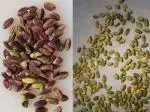This site uses only a few technical cookies necessary for its operation. By continuing to browse, you accept their use.
To find out more...
To find out more...
Sushi
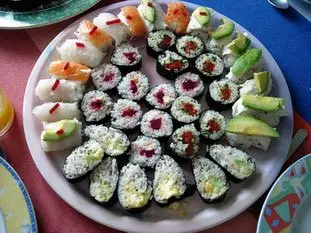
Sushi is probably the best known element of Japanese cooking outside Japan. For the Japanese it's a culinary art learned over time from masters, but we can make simplified and easier sushi which are still pretty and delicious.
The most common types of sushi are nigiri: a little oval-shaped mouthfuls of rice topped with raw fish, and maki: a nori seaweed roll filled with rice and other delicious ingredients.
The most common types of sushi are nigiri: a little oval-shaped mouthfuls of rice topped with raw fish, and maki: a nori seaweed roll filled with rice and other delicious ingredients.
356 K 4.4/5 (22 reviews)
Last modified on: October 13th 2010
For 6 people, you will need:
- 1
 400 g rice
400 g rice - 2
 150 ml rice vinegar
150 ml rice vinegar - 3
 1 tablespoon salt
1 tablespoon salt - 4
 1 teaspoon caster sugar
1 teaspoon caster sugar - 5
 3 tablespoons sesame seeds (optional)
3 tablespoons sesame seeds (optional) - 6
 100 g Fish
100 g Fish - 7
 ½ teaspoon wasabi
½ teaspoon wasabi - 8
 6 noris sheet
6 noris sheet - 9
 1 cucumber
1 cucumber - 10
 1 raw beetroot
1 raw beetroot - 11
 1 egg
1 egg - 12
 1 avocado
1 avocado - 13
 4 preserveds tomatoes
4 preserveds tomatoes - 14
 Basil
Basil - 15
 2 tablespoons soy sauce
2 tablespoons soy sauce - 16
 3 tablespoons vinegar
3 tablespoons vinegar - 17
 2 tablespoons water
2 tablespoons water - 18
 5 drops Tabasco
5 drops Tabasco - Total weight: 1,670 grams
Times for this recipe
Preparation: 1 hour 25 min.
Cooking: 15 min.
All in all: 1 hour 40 min.
If you start now, at , you will finish around : ?.Change start time
To finish around 7pm, you'll need to have started before: .Change end time
Step by step recipe
Stage 1 - ⌛ 5 min.
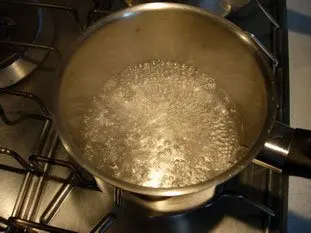
Cook 400 g rice (a rice-cooker is useful). Normally you should use Japanese round rice, but for this adapted recipe, it's not absolutely necessary.
Meanwhile, pour 150 ml rice vinegar into a pan, bring to the boil and add 1 tablespoon salt and 1 teaspoon caster sugar, stir to mix and remove from heat.
Equally, if you don't have rice wine vinegar, use normal vinegar instead, white or wine vinegar, (in which case your rice will take on a pretty light pink colour).
Meanwhile, pour 150 ml rice vinegar into a pan, bring to the boil and add 1 tablespoon salt and 1 teaspoon caster sugar, stir to mix and remove from heat.
Equally, if you don't have rice wine vinegar, use normal vinegar instead, white or wine vinegar, (in which case your rice will take on a pretty light pink colour).
Stage 2 - ⌛ 1 min.
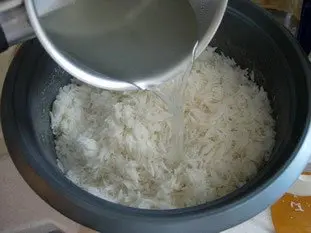
Pour vinegar onto rice and mix well.
Stage 3 - ⌛ 5 min.
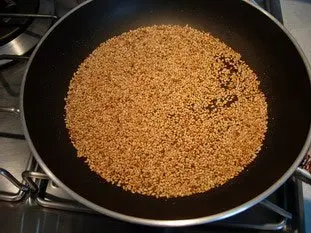
Cook 3 tablespoons sesame seeds in a frying pan without fat 4 or 5 minutes, stirring from time to time to roast (torrefy).
Stage 4 - ⌛ 3 min.

Mix sesame seed with half the rice to get two kinds: plain and sesame that you can use as you choose in the following recipe.
Stage 5
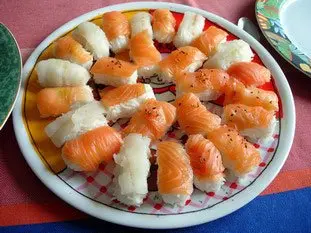
Nigiris :
Nigiris are little oval-shaped cakes of rice, usually covered with a thin layer of raw fish, but this can be varied in many ways.
Nigiris are little oval-shaped cakes of rice, usually covered with a thin layer of raw fish, but this can be varied in many ways.
Stage 6 - ⌛ 5 min.
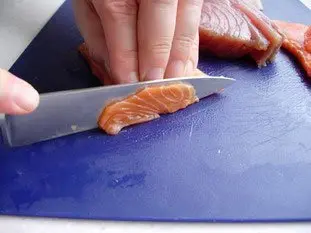
Cut your fish into wafer thin slices (see below on choosing your fish).
Stage 7
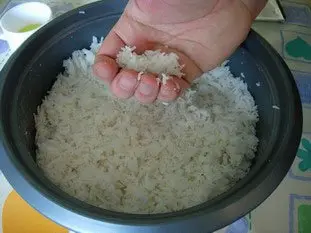
Make rice cake: take a little rice in your fingers...
Stage 8
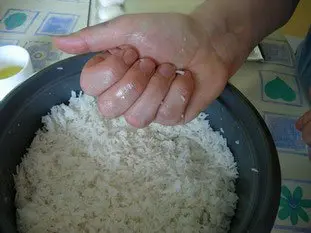
...close your hand round it a few times to shape...
Stage 9
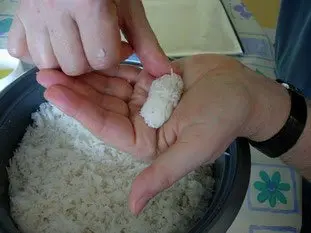
... and tidy ends if necessary.
Stage 10
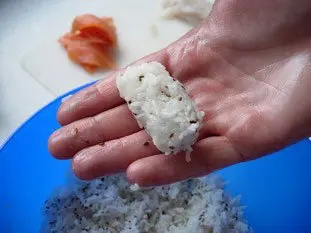
A rice cake with sesame rice.
Note: if rice sticks to your fingers too much, rub your hands with a few drops of oil from time to time.
Note: if rice sticks to your fingers too much, rub your hands with a few drops of oil from time to time.
Stage 11
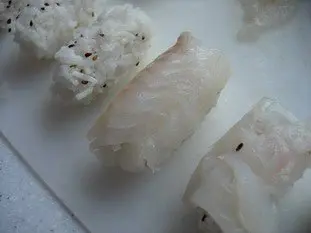
Put a thin layer of fish on top of rice.
The best way to do this is by sushi-factory production line, see below.
The best way to do this is by sushi-factory production line, see below.
Stage 12 - ⌛ 30 min.
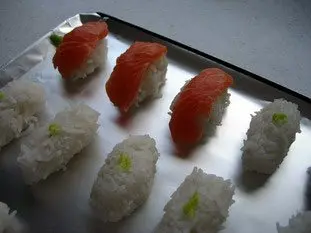
Before adding fish, you can add some wasabi.
Tip from Jeremy: mark this hot sushi with a discreet label like a sesame seed on top for example.
Tip from Jeremy: mark this hot sushi with a discreet label like a sesame seed on top for example.
Stage 13
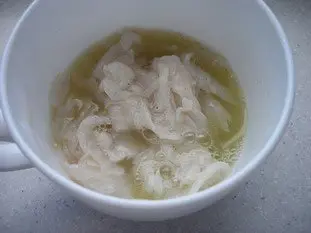
Nigiris can be filled with many other things rather than raw fish, here are some ideas, but also let your imagination and taste guide you.
Tahitian-style fish marinated 1 hour in lime juice with salt and pepper.
Tahitian-style fish marinated 1 hour in lime juice with salt and pepper.
Stage 14
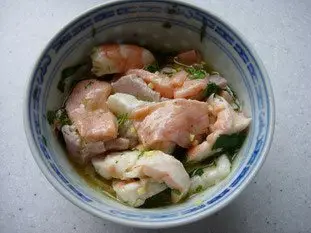
Thin layer of fish, prawns or scampi, marinated in a mix of olive oil, lemon juice and herbs.
Stage 15
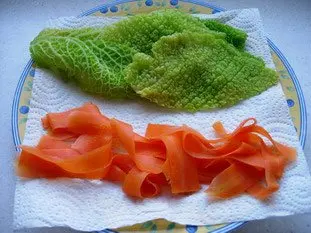
Vegetables, cut into thin strips or leaves, raw or just blanched.
Smoked salmon or other smoked fish, etc.
yes you're right this is not sushi anymore (A restaurant in Paris is famous for its foie gras sushi), but it's still delicious, so why not?.
Smoked salmon or other smoked fish, etc.
yes you're right this is not sushi anymore (A restaurant in Paris is famous for its foie gras sushi), but it's still delicious, so why not?.
Stage 16
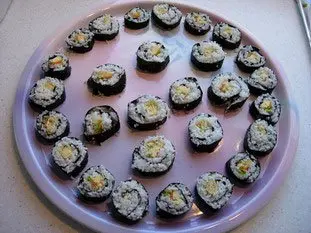
Makis:
Makis are sheets of nori seaweed filled with rice and other ingredients, and rolled up to produce a green roll, which is then sliced to give the individual maki sushi.
Makis are sheets of nori seaweed filled with rice and other ingredients, and rolled up to produce a green roll, which is then sliced to give the individual maki sushi.
Stage 17 - ⌛ 10 min.
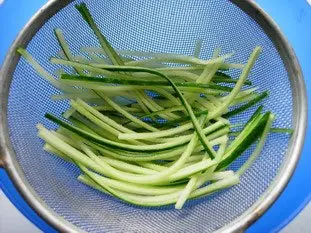
Cut your vegetables into small sticks, raw for cucumber...
Stage 18 - ⌛ 10 min.
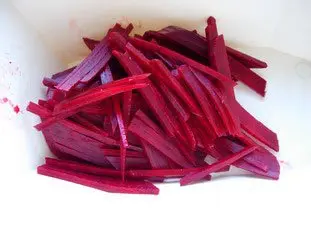
... blanched or cooked for beetroot...
Stage 19 - ⌛ 5 min.
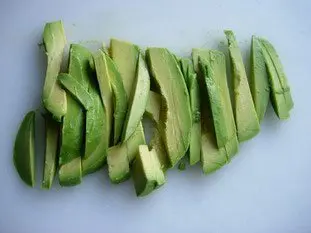
...raw too for avocado.
Stage 20 - ⌛ 5 min.

Beat 1 egg with a fork, and cook in a frying pan to make a sort of small omelette.
Stage 21 - ⌛ 5 min.
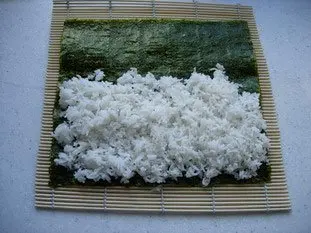
Put a nori sheet on a sushi mat (or if you don't have one, on a towel ).
Cover with rice over 2/3 of surface, not too thickly, about 1/4 inch or 1/2 cm.
Cover with rice over 2/3 of surface, not too thickly, about 1/4 inch or 1/2 cm.
Stage 22 - ⌛ 5 min.
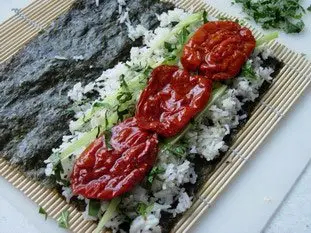
Put the chosen ingredients for your maki on the rice, here: cucumber, basil, and tomato preserve (recipe from Ann and Jeremy).
Stage 23 - ⌛ 1 min.
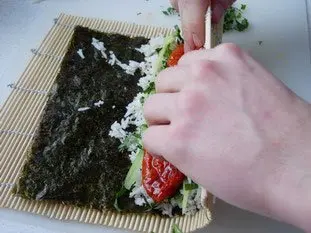
Raise mat to roll sheet on itself...
Stage 24 - ⌛ 2 min.
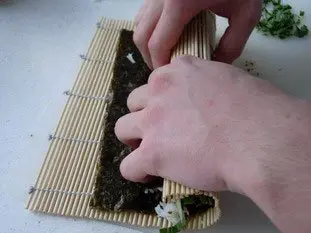
...continue shaping by rolling tightly all the way...
Stage 25 - ⌛ 1 min.
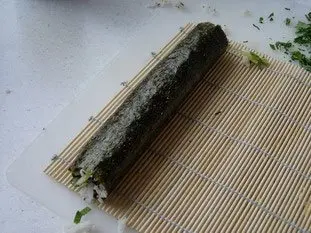
...to the end.
Finish by leaving the edge of nori sheet under the roll.
Finish by leaving the edge of nori sheet under the roll.
Stage 26 - ⌛ 2 min.
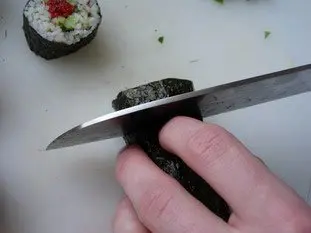
Cut roll into thick slices.
Stage 27
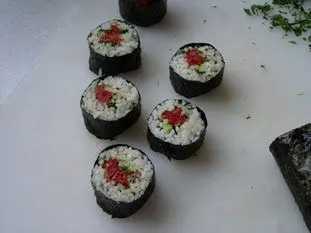
But not more than ½ inch or 1 cm.
Stage 28
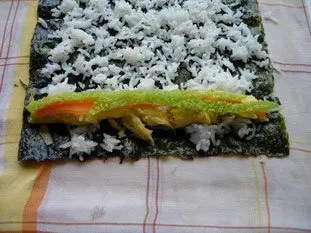
Another idea: strips of carrot, cabbage and omelette.
Stage 29
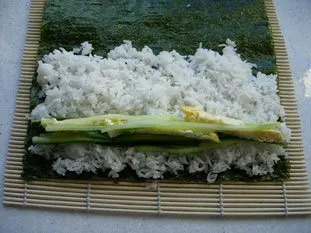
Cucumber and omelette.
Stage 30
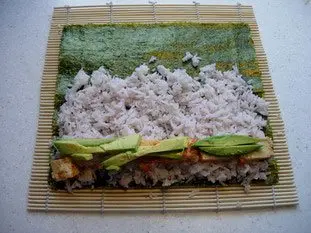
Avocado and marinated fish.
Let your imagination run wild.
Let your imagination run wild.
Stage 31 - ⌛ 3 min.
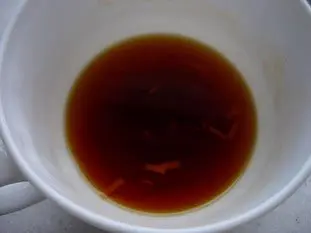
Make a quick sauce by mixing in a bowl 2 tablespoons soy sauce, 3 tablespoons vinegar, 2 tablespoons water, 5 drops Tabasco and a little grated carrot.
Stage 32
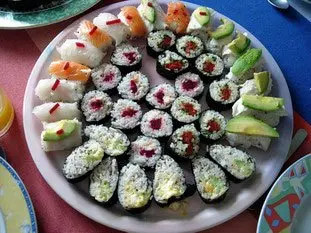
Serve if possible on large plates, arranging different nigiri and maki, as pretty to look as they are delicious to eat.
Remarks
If you serve these sushi as a starter, allow 4 or 5 per guest. For a sushi-party, about 10 and as varied as possible.
For sushi with raw fish, you should make sure that it's fresh and of the highest quality. You do not need a lot, so it's worth investing in something good - have confidence in your fishmonger.
It's also a good time to try lesser known fish: never use red tuna (Alabcore or Tunus, which will probably disappear from the oceans soon, as a result of human stupidity), but opt for organic salmon, mackerel or sardines.
Sushi can't be kept waiting too long, it's so impossible to make them the day before. 1 or 2 hours should be the maximum. The best way is to make them and eat them straight away.
For complete success, the best way is to start a sushi-factory: one person (or two) make little rice cakes, another adds wasabi, another adds fish, someone else looks after plates and their filling, and so one. This method allows fast production, and gets everybody, including guests, in the kitchen, talk and laughing, and you get nice fresh sushi.
It might be better if yet another person opens wine bottles and fills glasses (Robert is a master in this art).
For sushi with raw fish, you should make sure that it's fresh and of the highest quality. You do not need a lot, so it's worth investing in something good - have confidence in your fishmonger.
It's also a good time to try lesser known fish: never use red tuna (Alabcore or Tunus, which will probably disappear from the oceans soon, as a result of human stupidity), but opt for organic salmon, mackerel or sardines.
Sushi can't be kept waiting too long, it's so impossible to make them the day before. 1 or 2 hours should be the maximum. The best way is to make them and eat them straight away.
For complete success, the best way is to start a sushi-factory: one person (or two) make little rice cakes, another adds wasabi, another adds fish, someone else looks after plates and their filling, and so one. This method allows fast production, and gets everybody, including guests, in the kitchen, talk and laughing, and you get nice fresh sushi.
It might be better if yet another person opens wine bottles and fills glasses (Robert is a master in this art).
And to drink?
A red wine that's not too strong, like a Beaujolais for example, otherwise a rosé.
Keeping: Several hours in the fridge, covered by a plastic film.
Source: Family recipe, everyone got involved.
Nutritional information
| Proteins (gr) | Carbohydrates (gr) | Fats (gr) | Energy value (in k-calories) | Energy value (in k-joules) | |
|---|---|---|---|---|---|
| Whole recipe | 100 RDI=40 % | 150 RDI=10 % | 230 RDI=40 % | 1,450 RDI=70 % | 6,080 RDI: 70 % |
| Per 100 g | 5 RDI=2 % | 8 RDI=1 % | 10 RDI=2 % | 90 RDI=4 % | 360 RDI: 4 % |
| Per person | 20 RDI=6 % | 20 RDI=2 % | 40 RDI=6 % | 240 RDI=10 % | 1,010 RDI: 10 % |
How much will it cost?
- For 6 people : 8.55 €
- Per person : 1.45 €
Change currency:
Note: Be careful, these prices are only an estimate, you can consult the table of prices by ingredients used for this estimate.
This recipe uses (among others)

Rice
Like these other recipes: Morel risotto with Vin Jaune and Mont d'Or, Chantilly rice pudding, Crispy spinach rolls, Risotto with zucchinis and cherry tomatoes, Indian rice pudding, ... See them all 22

Rice vinegar
Like these other recipes: Thai-style Chicken with Cashew Nuts, ... See them all 1

Fish
Like these other recipes: Seafood sauerkraut, Quiche Bretonne, Warm autumn salad, Fish in a salt crust, Fish in a sesame crust, ... See them all 8
Other recipes you may also like
Lobster Thermidor
In this recipe, the lobster are cooked first in a court bouillon (stock), then the flesh is removed and cut into small pieces before being cooked with the cream and alcohol. The dish is browned in the oven to finish. January 22th 2012176 K 14.7 35 min.
Saint Honoré cake
The Saint Honoré cake is a famous example of French patisserie. It consists of a puff pastry base surrounded by a ring of caramel-coated choux puffs and topped with whipped cream (Chantilly). It is a bit tricky to make, but this recipe gives you all the hints you need. April 14th 2013140 K4.7 2 hours 55 min.
Santiago Cake
Santiago cake (or Torta de Santiago) has a lovely moist texture. It is made with almonds and lemon and contains no butter or flour. This Spanish speciality from Galicia is still often decorated with the cross of St James. April 24th 201686 K5 55 min.
How to peel pistachios
If you buy pistachios shelled but still in their skins (cheaper than ready peeled), you shouldn't use them like this. They need to be "skinned", removing the skin which is pretty unpleasant to eat. Here's a fairly easy way to do it. May 20th 2020151 K3.3 30 min.
Candied grapefruit peel
Not really a dessert, more a kind of sweet. After soakiing, strips of grapefruit skin are cooked very slowly to conservethem in sugar. It's a real treat with coffee at the end of a meal. December 20th 2018394 K 14 1 day 1 hour 25 min.
News list of cooking-ez.com
Sign up to receive the latest recipes (next batch due to be sent on 2026-01-04)
Note: We'll never share your e-mail address with anyone else.
Post a comment or question
Follow this recipe
If you are interested in this recipe, you can "follow" it, by entering your email address here. You will then receive a notification immediately each time the recipe is modified or a new comment is added. Please note that you will need to confirm this following.
Note: We'll never share your e-mail address with anyone else.
Alternatively: you can subscribe to the mailing list of cooling-ez.com , you will receive a e-mail for each new recipe published on the site.



